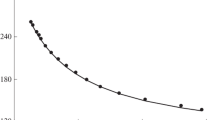Abstract
A quantitative structure-property relationship (QSPR) model obtained by using multiple linear stepwise regression analysis, with correlation coefficient R of 0.979 for the training set and 0.951 for the validation set, was developed to predict the glass transition temperature (T g) values of polyacrylates. Three quantum chemical descriptors (the molecular average polarizability α, the entropy S, and the lowest unoccupied molecular orbital E LUMO) obtained directly from polyacrylates monomer structure by density function theory (DFT) calculation, were used to produce the model. The result confirmed the role that quantum chemical descriptors play in studying QSPR of glass transition temperature for polymers.
Similar content being viewed by others
References
J. Bicerano, Encyclopedia of Polymer Science and Technology, Wiley, New York (2003).
J. Bicerano, Prediction of Polymers Properties, 3rd edn., Marcel Dekker, New York (2002).
D. W. van Krevelen, Properties of Polymers: Their Correlation with Chemical Structure, Their Numerical Estimation, Prediction from Additive Group Contributions, 3rd edn., Elsevier, Amsterdam (1990).
J. Hopfinger and M. G. Koehler, J. Polym. Sci. Part B: Polym. Phys., 26, 2007 (1988).
V. O. Toropov, N. L. Kudyshkin, I. N. Voropaeva, et al., J. Struct. Chem., 45, 945 (2004).
M. Yu. Smirnov, A. V. Kalinkin, and V. I. Bukhtiyarov, ibid., 48, 1053 (2007).
R. Katrizky, P. Rachwal, K. W. Law, et al., J. Chem. Inf. Comput. Sci., 36, 879 (1996).
R. Katritzky, S. Sild, V. Lobanov, and M. Karlson, ibid., 38, 300 (1998).
X. L. Yu, X. Y. Wang, X. B. Li, et al., Macromol. Theory Simul., 15, 94 (2006).
J. Brandrup, E. H. Immergut, and E. A. Grulke, Polymer Handbook, 4th edn., Wiley-Interscience, New York (1999).
A. Afantitis, G. Melagraki, H. Sarimveis, et al., Polymer, 47, 3240 (2006).
E. Mattioni and P. C. Jurs, J. Chem. Inf. Comput. Sci., 42, 232 (2002).
R. García-Domenech and J. V. de Julián-Ortiz, J. Phys. Chem. B, 106, 1501 (2002).
M. J. Frisch, G. W. Trucks, H. B. Schlegel, et al., Gaussian-03, Revision B.03, Gaussian Inc., Pittsburgh PA (2003).
D. Becke, J. Phys. Chem., 98, 5648 (1993).
C. Lee, W. Yang, and R. G. Parr, Phys. Rev. B, 37, 785 (1988).
A. Golbraikh and A. Tropsha, J. Mol. Grap. Model, 20, 269 (2002).
A. Tropsha, P. Gramatica, and V. K. Gombar, Quant. Struct. Act. Relat. Comb. Sci., 22, 69 (2003).
Author information
Authors and Affiliations
Corresponding author
Additional information
Original Russian Text Copyright © 2009 by X. L. Yu, W. H. Yu, and X. Y. Wang
The text was submitted by the authors in English. Zhurnal Strukturnoi Khimii, Vol. 50, No. 5, pp. 859–864, September–October, 2009.
Rights and permissions
About this article
Cite this article
Yu, X.L., Yu, W.H. & Wang, X.Y. DFT-based quantum theoretic QSPR studies of the glass transition temperatures of polyacrylates. J Struct Chem 50, 821–826 (2009). https://doi.org/10.1007/s10947-009-0123-y
Received:
Published:
Issue Date:
DOI: https://doi.org/10.1007/s10947-009-0123-y




